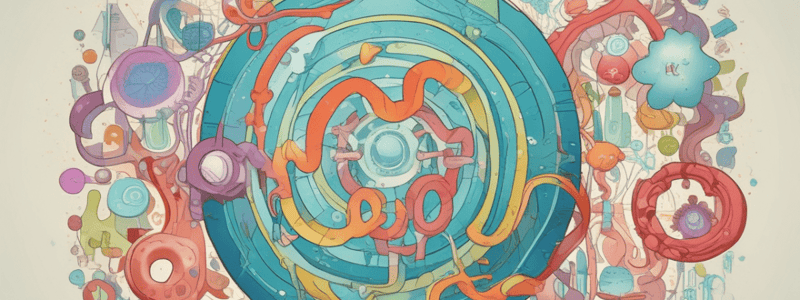Podcast
Questions and Answers
What is the primary function of protein catabolism in the human body?
What is the primary function of protein catabolism in the human body?
- To synthesise proteins from amino acids
- To convert amino acids into glucose or triglycerides
- To store excess proteins in the body
- To break down proteins into their constituent amino acids for further metabolism (correct)
What is the percentage of body weight that is comprised of nitrogen in a 70kg male?
What is the percentage of body weight that is comprised of nitrogen in a 70kg male?
- 3% (correct)
- 2%
- 5%
- 1%
During which stage of protein catabolism is the removal or exchange of functional groups involved?
During which stage of protein catabolism is the removal or exchange of functional groups involved?
- Protein anabolism
- Stage 2 - catabolism of amino acids (correct)
- Nitrogen metabolism
- Stage 1 - GI tract
What is the net result of a negative nitrogen balance in the body?
What is the net result of a negative nitrogen balance in the body?
What is the primary function of protein anabolism?
What is the primary function of protein anabolism?
What is the role of pepsin and HCl in the GI tract during protein catabolism?
What is the role of pepsin and HCl in the GI tract during protein catabolism?
What is the term for the process of breaking down proteins into their amino acids?
What is the term for the process of breaking down proteins into their amino acids?
What is the result of excess proteins in the body being converted into glucose or triglycerides?
What is the result of excess proteins in the body being converted into glucose or triglycerides?
Flashcards are hidden until you start studying
Study Notes
Proteins
- Proteins have multiple functions, including: cell signalling receptors, structural members of membranes, enzymes, ion pumps, ion channels, and transporters (e.g. haemoglobin)
- Excess proteins can serve as a metabolic fuel source and be converted into glucose or triglycerides for energy or energy reserves
- Proteins are synthesised from amino acids, and essential amino acids must be obtained from the diet
Protein Metabolism
- Protein anabolism is the process by which proteins are formed from amino acids
- There are 20 amino acids involved in protein synthesis
Protein Catabolism
- Stage 1 of protein catabolism occurs in the GI tract:
- Stomach: pepsin and HCl denature proteins at low pH
- Small intestine: digestive enzymes (secretin and CCK) break down polypeptide chains into smaller peptides
- Pancreas: digestive enzymes further break down peptides
- Protein catabolism is also called proteolysis and can lead to further amino acid degradation
Catabolism of Amino Acids
- Stage 2 of protein catabolism involves the catabolism of amino acids:
- Removal or exchange of functional groups
- Release of excess nitrogen in the form of ammonium (NH4+)
- Catabolism of the remaining carbon skeleton, which participates in different routes in the body
Nitrogen Metabolism
- Nitrogen metabolism refers to the metabolic processes related to the metabolism of all nitrogen-containing compounds (N-compounds)
- The human body (70kg male) contains approximately 2.0kg of nitrogen, accounting for ~3% of body weight
Nitrogen Balance
- Nitrogen balance is the measure of nitrogen output subtracted from nitrogen input
- A negative nitrogen balance is associated with malnourishment and/or overtraining, indicating that catabolic processes are overriding anabolic ones
- A positive nitrogen balance is often found during periods of over nutrition
Studying That Suits You
Use AI to generate personalized quizzes and flashcards to suit your learning preferences.




